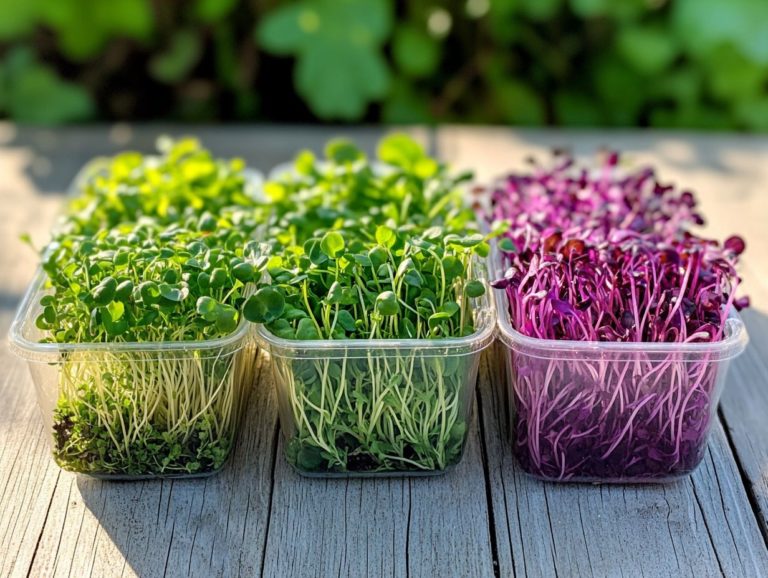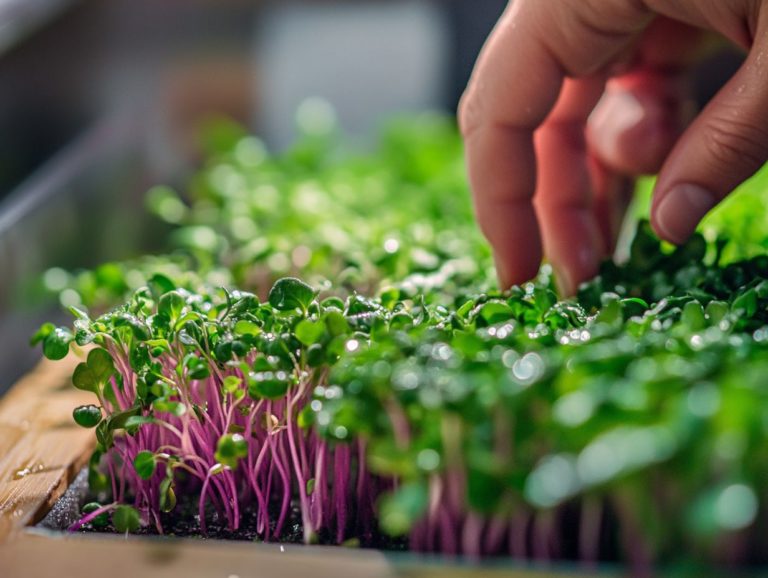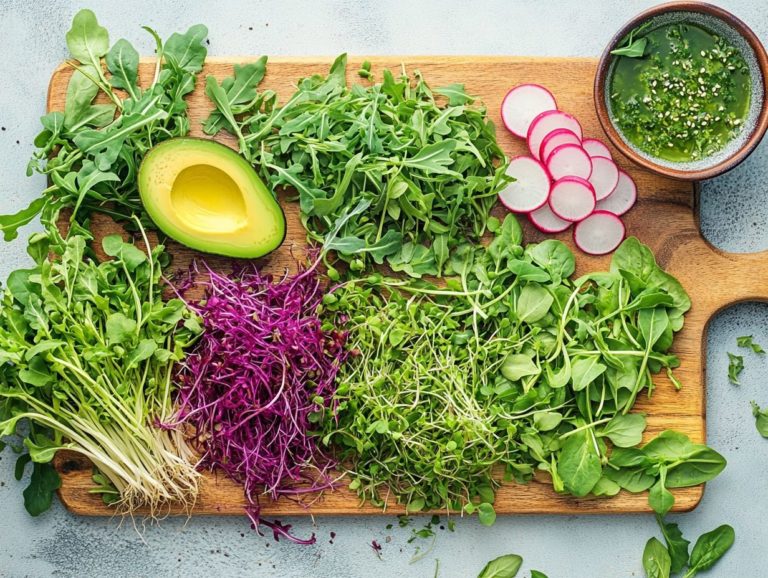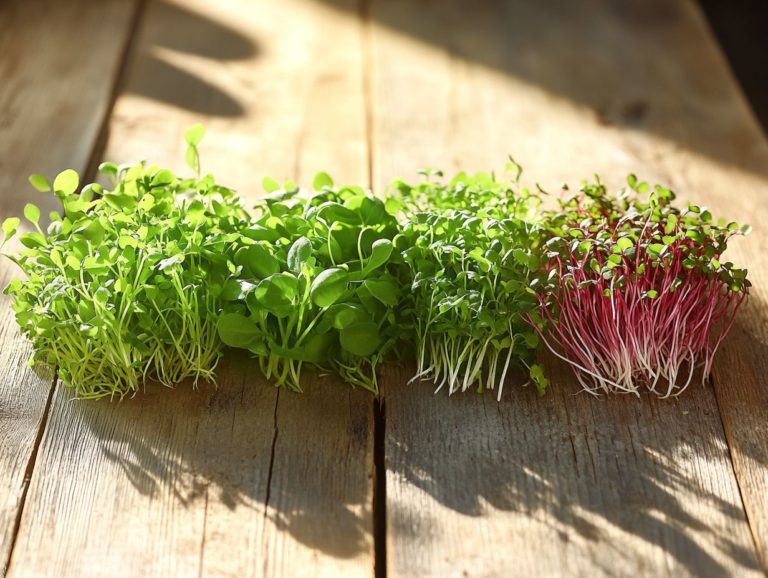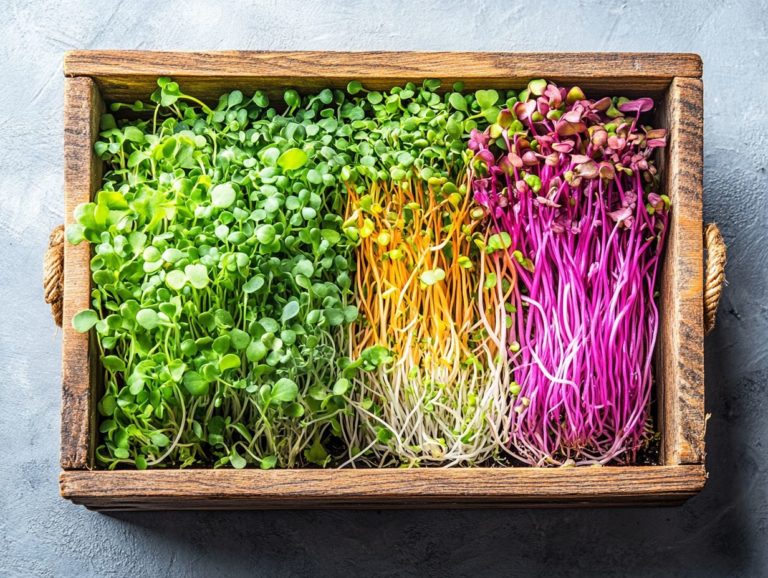The Role of Microgreens in Healthy Eating
Microgreens are tiny plants packed with nutrients. They have become popular among chefs and health enthusiasts. These vibrant greens boost the taste of any dish and are rich in vitamins and minerals. You can easily grow them at home!
This article explores the fascinating world of microgreens, highlighting their health benefits and guiding you on how to seamlessly incorporate them into your meals. You will discover how to embrace these delightful additions for a healthier lifestyle and improve your gut health.
Contents
Key Takeaways:
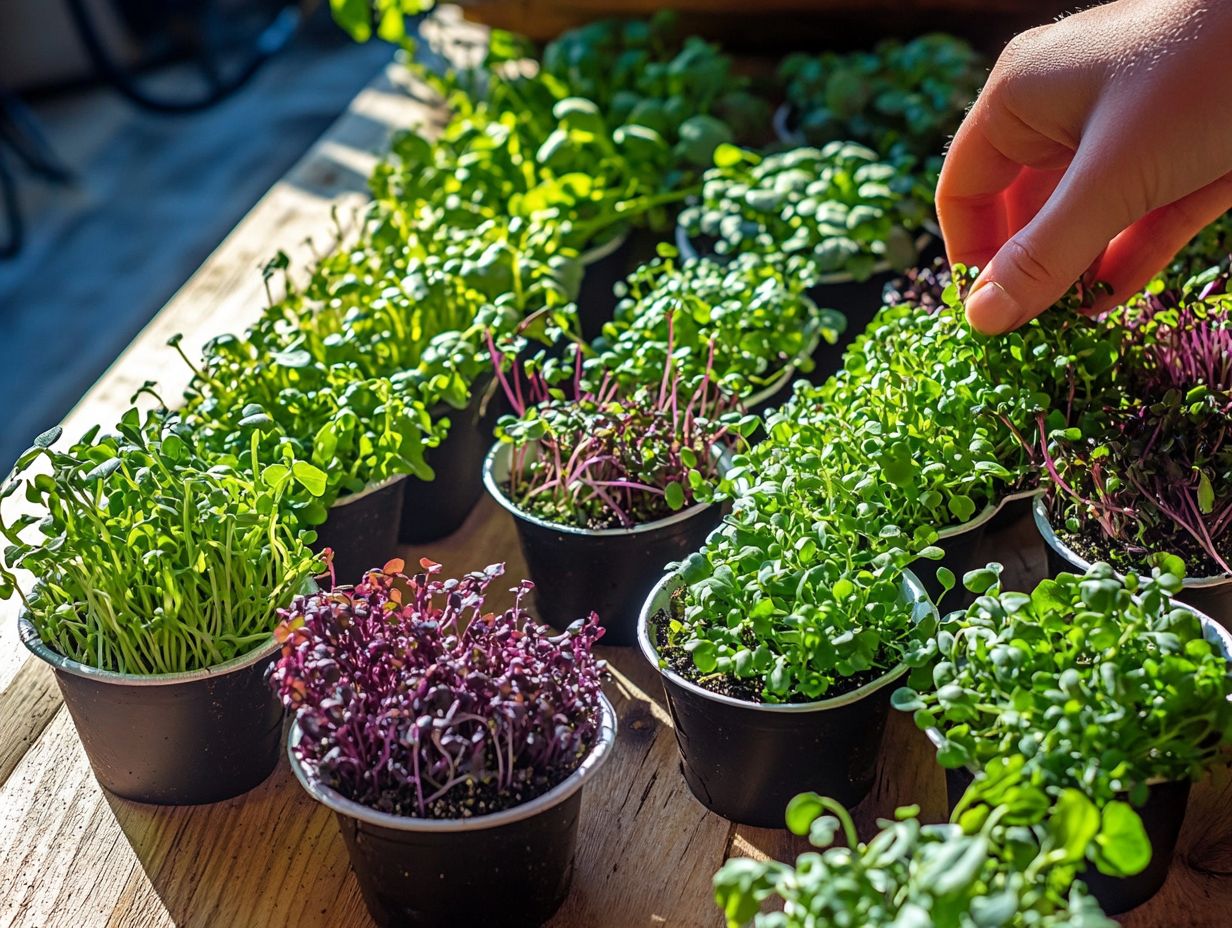
- Microgreens are nutrient-dense, miniature versions of fully grown greens with a higher concentration of vitamins, minerals, and antioxidants, making them a valuable addition to a healthy diet.
- Including microgreens in your meals can help improve nutrient intake and provide anti-inflammatory and antioxidant benefits, contributing to overall health and well-being.
- Growing your own microgreens is easy and cost-effective, with a variety of options to choose from that enhance any dish.
What are Microgreens?
Microgreens are young plants harvested just after they ve developed their first true leaves. They are known for their bright colors, concentrated nutrients, and remarkable culinary versatility.
These petite greens deliver a nutritional powerhouse, offering an array of health benefits that can elevate your balanced diet. Typically harvested within 7 to 21 days after germination, they include various species like broccoli, spinach, and red cabbage, all members of the Brassicaceae family.
Microgreens are recognized as superfoods in the health community, contributing significantly to overall well-being.
Definition and Characteristics
Microgreens are young, edible plants harvested just after germination. They come from various plant families, notably the Brassicaceae family, which includes familiar vegetables like broccoli and radish. These little greens may be small, but they pack a punch with their bold flavors, vibrant colors, and impressive nutrient density, making them a fantastic addition to your dishes.
You can grow these tiny gems through various methods, whether you prefer soil-based systems or hydroponics. Each type offers its own unique flair; for instance, arugula microgreens bring a delightful peppery bite, while pea shoots add sweetness and crispness.
Their rising popularity in the culinary world is no surprise, as both chefs and home cooks recognize their ability to inject freshness, visual appeal, and complex flavor profiles into everything from salads and sandwiches to gourmet entrees. With microgreens, you can transform simple meals into artistic expressions of culinary creativity.
Nutritional Value of Microgreens
People love microgreens for their incredible nutritional value, often boasting higher levels of essential nutrients than their mature counterparts think vitamins K and C, iron, and potassium. They act as a concentrated source of dietary fiber and natural substances that can promote health, making them an excellent addition to a health-conscious diet.
Research indicates that specific microgreens, like broccoli and red cabbage, can offer substantial health benefits, including cancer prevention and enhanced gut health. Incorporating them into your meals can significantly elevate your nutritional game and contribute to the role of microgreens in holistic health.
Comparison to Other Greens
When you compare microgreens to other leafy greens, it quickly becomes clear that microgreens provide a remarkable nutritional boost in smaller servings. They boast higher concentrations of vitamins and minerals, like vitamin C, iron, and potassium.
Research shows that some microgreens can carry up to 40 times more essential nutrients than their mature counterparts, making them an incredibly efficient addition to your diet.
In terms of flavor, microgreens offer a delightful variety, from the peppery kick of arugula to the refreshing essence of basil. This burst of flavor elevates your meals beyond mere nutrition and inspires you to embrace more vegetables in your diet, promoting overall health. To learn more about their benefits, check out why microgreens are essential for a balanced diet.
With their compact size and vibrant colors, these greens are not just a culinary treat; they also deliver substances that protect your body, supporting immune function and overall well-being. To learn more about their advantages, explore the health benefits of microgreens, which positions them as a superior alternative to traditional leafy greens.
Benefits of Including Microgreens in Your Diet

Incorporating microgreens into your diet presents an impressive array of health benefits. You’ll experience improved nutrient intake, enhanced antioxidant properties, and potential protective effects against chronic diseases such as Type 2 diabetes and various forms of cancer.
These petite greens are packed with phytochemicals that bolster your immune system and promote overall well-being. By regularly consuming microgreens, you’re also contributing to better gut health and improved digestion, positioning the top microgreen varieties for health enthusiasts as an essential element of a healthy, balanced diet.
Improved Nutrient Intake
Microgreens can significantly elevate your nutrient intake, offering a concentrated source of essential vitamins and minerals in remarkably small servings. They’re particularly rich in vitamins A, C, E, and K, as well as essential minerals like iron and potassium, making them an excellent addition to your balanced diet.
Unlike traditional vegetables, which often demand larger portions to deliver similar nutrient levels, these tiny greens deliver a powerful punch in just a few tablespoons. Their high fiber content not only aids digestion but also promotes a satisfying feeling of fullness, which can assist you in managing your weight. To learn more about their benefits, check out understanding microgreens and their health advantages.
The vibrant flavors of microgreens have the power to elevate any dish from salads to sandwiches and even smoothies making it effortless to weave them into your daily meals. Consider sprinkling some onto your morning eggs or blending them into a fresh pesto for an added nutrient boost.
You ll find an exciting variety of microgreens at farmers’ markets and local grocery stores, providing you with ample options to enhance your culinary creations.
Antioxidant and Anti-inflammatory Properties
People love microgreens for their powerful antioxidant and anti-inflammatory benefits, which can effectively combat oxidative stress and enhance your overall health. These benefits are especially crucial in the realm of disease prevention, as the bioactive compounds found in microgreens may reduce the risk of chronic conditions, including heart disease and neurodegenerative disorders.
Rich in vitamins, minerals, and powerful antioxidants like vitamin C, vitamin E, and a variety of flavonoids, these tiny greens certainly pack a nutritional punch. For example, microgreens such as kale and broccoli are particularly abundant in sulforaphane, a powerful compound known for fighting cancer. By helping to neutralize harmful free radicals, these antioxidants play a vital role in cellular repair and regeneration, as detailed in unlocking the antioxidant power of microgreens.
Microgreens also boost your immune system, enhancing your body’s defenses. Incorporating them into your daily diet not only elevates your nutrient intake but also fortifies your body against various ailments, providing a simple yet effective pathway to improving your health and wellness.
Don’t miss out on the incredible health benefits of microgreens! Give microgreens a try today and supercharge your meals with flavor and nutrition!
How to Incorporate Microgreens into Your Meals
Incorporating microgreens into your meals is a simple yet impactful way to elevate both nutrition and food appeal. These petite greens are incredibly versatile, serving as delightful garnishes for salads and soups. They also blend seamlessly into smoothies and sandwiches. Try adding these tiny greens to your meals today!
They provide a burst of fresh flavor and deliver concentrated nutrients. With their adaptability, you can explore a range of creative cooking techniques that enhance the taste of any dish while keeping your diet wholesome and vibrant.
Creative and Delicious Recipe Ideas
Explore a delightful array of creative and delicious recipe ideas that highlight the versatility of microgreens, transforming them into an enticing addition to your healthy diet. Whether you re crafting vibrant salads or gourmet sandwiches, these tiny greens will skyrocket your meals’ flavor and health.
Start by tossing a mix of arugula and radish microgreens into your favorite salad for a peppery crunch. Alternatively, layer them into a whole-grain wrap with hummus and roasted vegetables for a satisfying lunch that is as nourishing as it is delicious. Incorporating these greens can also highlight the role of microgreens in sustainable eating.
If breakfast is calling, blend sunflower microgreens with your go-to smoothie ingredients for a fresh burst of flavor that’ll energize your morning. For dinner, sprinkle pea shoot microgreens on grilled salmon to enhance this protein-packed dish. Each of these suggestions showcases the unique taste of microgreens and adds a wealth of vitamins and antioxidants, supporting your overall well-being. Don’t miss out on these health benefits!
Growing Your Own Microgreens
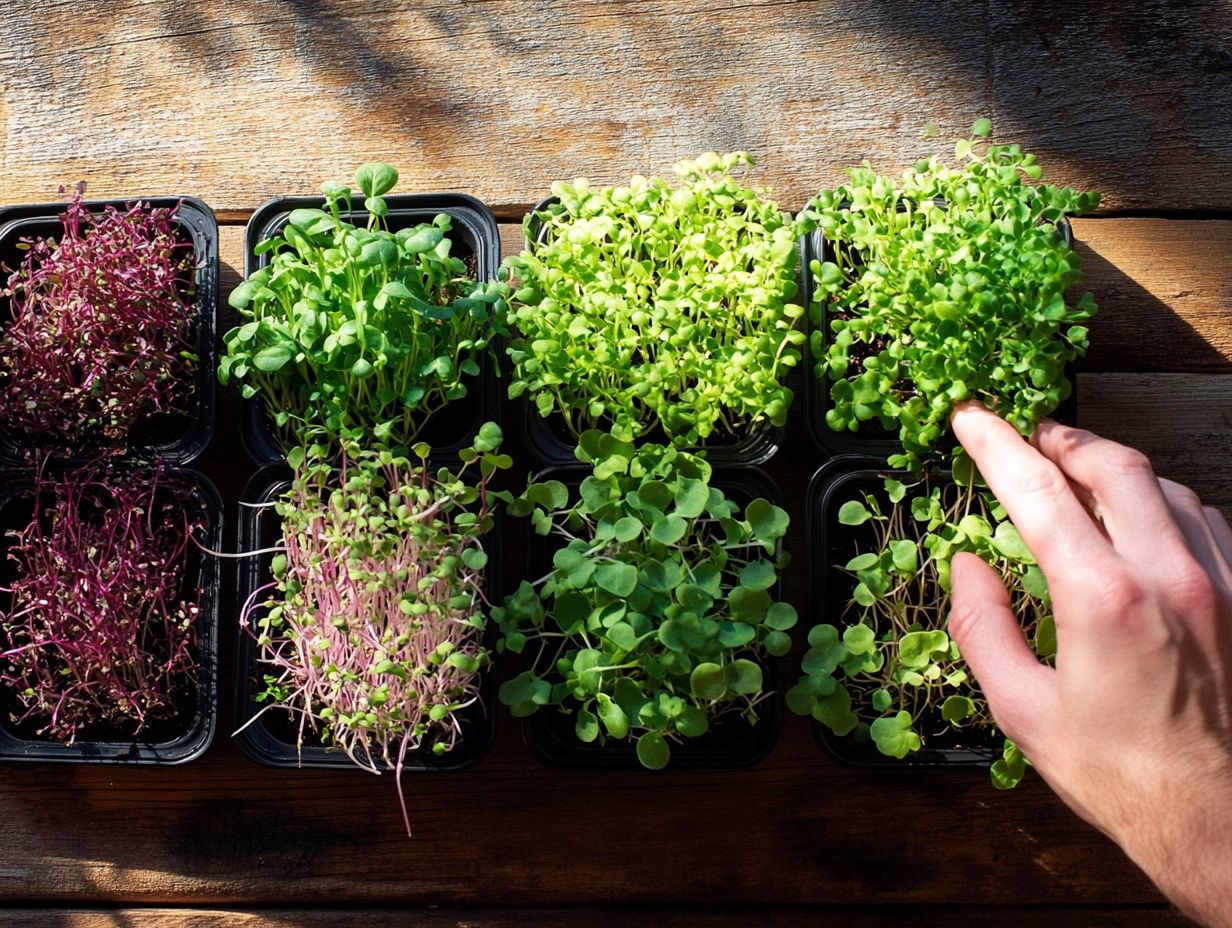
Growing your own microgreens is a truly rewarding pursuit that offers fresh produce right at your fingertips, along with the environmental benefits that come with home gardening.
These tiny greens are remarkably easy to cultivate, requiring minimal space and resources. This makes them an accessible choice for both novice and seasoned gardeners alike.
With a diverse array of seeds at your disposal, you can harvest nutrient-rich greens (greens that are packed with vitamins and minerals) directly from your kitchen countertop, elevating your meals while playing a part in sustainability.
Simple Steps and Tips for Success
To successfully grow microgreens at home, follow these straightforward steps and tips to ensure your garden flourishes. Begin with high-quality seeds and choose a suitable growing medium.
Make sure to provide adequate light and moisture for optimal germination and growth. Selecting a well-draining soil mix can significantly enhance your results by allowing for proper aeration and preventing waterlogging, which can be detrimental to young plants.
Place your containers in a sunny window or under grow lights for at least 12 to 16 hours daily. Insufficient light can lead to leggy seedlings that lack flavor.
Monitor moisture levels; while microgreens thrive in humidity, overwatering can lead to mold and root rot. By maintaining a balance and being mindful of common pitfalls, you ll find that growing microgreens can be both rewarding and enjoyable.
Choosing the Right Microgreens
Selecting the ideal microgreens for your culinary needs requires a keen understanding of the diverse varieties and their unique flavor profiles. Each type of microgreen brings its own character, enhancing your dishes while also delivering valuable nutritional benefits.
Whether you’re drawn to the zesty kick of spicy radish or the gentle sweetness of mild pea shoots, the right choice can elevate your cooking and amplify the health benefits of your meals.
Varieties and Flavor Profiles
Microgreens present a delightful spectrum of varieties, each boasting its own unique flavor profile and cooking uses offering endless opportunities to elevate your dishes. Popular choices like broccoli, fenugreek, and red cabbage can infuse your salads, sandwiches, and garnishes with distinctive tastes and textures, making them a splendid addition to any meal.
Delicate varieties like arugula and basil microgreens add a peppery or aromatic flavor to dishes, transforming simple pasta or fresh bruschetta into something extraordinary. The earthy undertones of beet greens beautifully complement grain bowls, while the vibrant hues of amaranth enhance a dish’s visual appeal, delighting both the eye and the palate. To learn more about their benefits, explore the science behind microgreens and health.
Whether you re a chef or a home cook, experimenting with a mix of these tiny greens allows you to explore their versatility, creating bright, flavorful experiences that tantalize the senses and inspire your culinary creativity. Try growing your own microgreens at home; it’s easy and rewarding!
Frequently Asked Questions
What are microgreens?
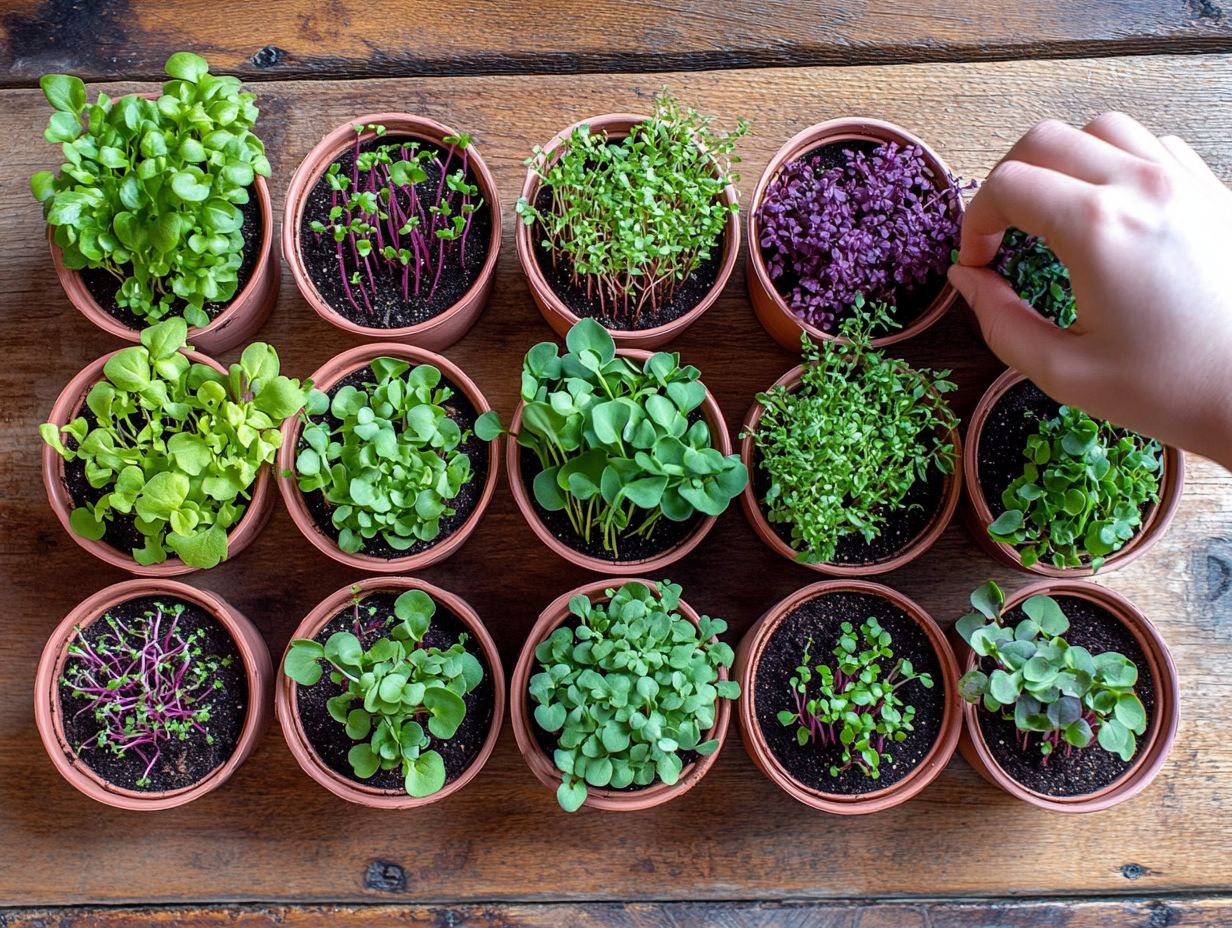
Microgreens are young vegetable greens harvested just after their first few sets of leaves have developed. They are smaller than baby greens and are packed with nutrients.
What is the role of microgreens in healthy eating?
Microgreens provide a nutrient-rich addition to your meals. They are loaded with vitamins, minerals, and antioxidants, boosting your overall health.
How do microgreens benefit our health?
Microgreens offer a wide range of health benefits, such as improved digestion, stronger immune systems, lower risk of chronic diseases, and increased energy levels. They help detoxify the body and promote healthy skin and hair.
Can microgreens help with weight loss?
Yes, microgreens can assist in weight loss due to their high nutrient content and low calorie count. They keep you feeling full and satisfied, reducing cravings for unhealthy snacks.
How can I incorporate microgreens into my diet?
Microgreens can be added to salads, sandwiches, smoothies, and even used as garnishes for various dishes. Their mild, delicate flavor pairs well with many different foods.
Are microgreens easy to grow at home?
Yes, microgreens are relatively easy to grow at home. They can be cultivated indoors with minimal equipment and space, making them a convenient and cost-effective way to add fresh, nutritious greens to your diet.

